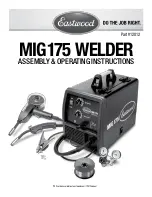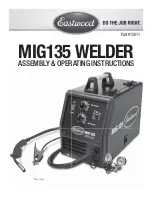
V4.0
MINIMIG 100E Flux-Cored Welder
8976052
Visit www.princessauto.com for more information
19
5.
Wipe off the excess grease on the outside of the nozzle with a finger or
towel and cover the welding tip with the grease.
6. Snip off the welding wire, leaving only a 1/4 in. at most.
7.
Screw the nozzle back into place and the MIG gun/torch is ready for use.
ATTACHING THE GROUND CLAMP
1.
Clean off dirt, oil, rust, scale, oxidation and paint from the workpiece
where the ground clamp will be attached.
2. Attach the ground clamp to the workpiece. Connect the ground clamp
directly to the workpiece and as close to the weld as possible to prevent
the welding current from traveling along an unexpected path, creating an
electric shock or fire hazard.
If this is not possible, connect the ground clamp to metal attached to the
workpiece, but is not electrically insulated from it. The metal must be of
equal or greater thickness than the workpiece when using this alternate
attachment point.
TURN THE POWER ON
1.
Plug the welding unit power cord into an outlet that meets the specified
power requirements (see Specifications).
2. Press the power switch to turn the welding unit ON.
WARNING! The welding unit is ‘live’ once turned on and can cause serious
electrical and burn injuries if mishandled. Take all precautions listed in this
manual when handling the welding unit.
SELECT THE WELDING AMPERAGE
The voltage selector controls the welding heat. Refer to the label inside the
welder side door for recommended settings for your welding job.
TUNING IN THE WIRE SPEED
WARNING! Exposure to a welding arc is extremely harmful to the eyes and
skin. Prolonged exposure to the welding arc can cause blindness and burns.
Never strike and arc or begin welding until you are adequately protected.
Wear flameproof welding gloves, a heavy long sleeved shirt, cuffless
trousers, high topped shoes and a welding helmet.
This is one of the most important parts of a MIG welding operation and must be
done before starting each welding job or whenever any of the following
variable are changes: heat setting, wire diameter or wire type.
















































